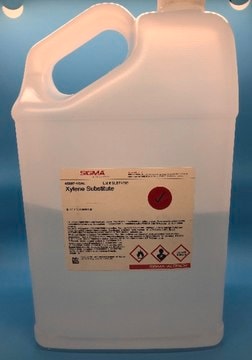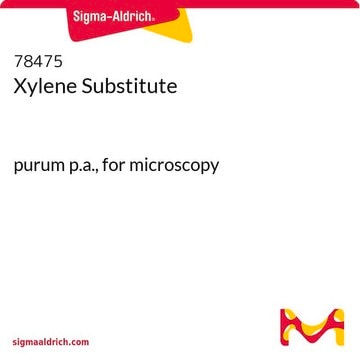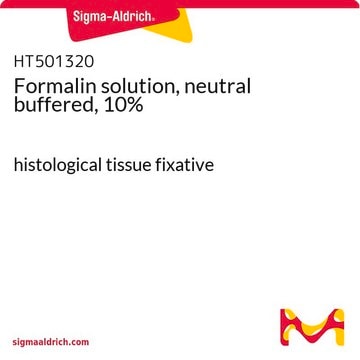H2904
HistoChoice® Tissue Fixative
Anmeldenzur Ansicht organisationsspezifischer und vertraglich vereinbarter Preise
Alle Fotos(1)
About This Item
UNSPSC-Code:
12352202
NACRES:
NA.47
Empfohlene Produkte
Anwendung
Designed for the molecular biologist. Specially formulated to preserve antigenic sites for antibody probes and nucleic acid sites for in situ hybridizations. Fixed sections do not require predigestion or other recovery procedures to make important sites available.
Qualität
Contains no formaldehyde, glutaraldehyde or mercury. Non-toxic
Rechtliche Hinweise
HistoChoice is a registered trademark of Amresco, Inc.
Signalwort
Danger
Gefahreneinstufungen
Acute Tox. 4 Inhalation - Eye Irrit. 2 - Flam. Liq. 2 - Muta. 2 - Skin Irrit. 2 - Skin Sens. 1 - STOT SE 3
Zielorgane
Respiratory system
Lagerklassenschlüssel
3 - Flammable liquids
WGK
WGK 3
Persönliche Schutzausrüstung
Eyeshields, Faceshields, Gloves, type ABEK (EN14387) respirator filter
Choose from one of the most recent versions:
Besitzen Sie dieses Produkt bereits?
In der Dokumentenbibliothek finden Sie die Dokumentation zu den Produkten, die Sie kürzlich erworben haben.
Kunden haben sich ebenfalls angesehen
D G Vince et al.
Analytical cellular pathology : the journal of the European Society for Analytical Cellular Pathology, 15(2), 119-129 (1997-01-01)
Formaldehyde fixatives have traditionally been used to preserve tissues as they impart excellent morphological preservation. Formaldehyde fixes tissue by cross linking, a process which can reduce the antigenicity of tissue and weakens the intensity of immunohistochemical stains. Preliminary studies have
M A Kacena et al.
Biotechnic & histochemistry : official publication of the Biological Stain Commission, 79(5-6), 185-190 (2005-03-15)
We compared histochemical and immunohistochemical staining as well as fluorochrome labeling in murine bone specimens that were fixed with 10% neutral buffered formalin to those fixed with HistoChoice. We showed that sections from undecalcified tibiae fixed for 4 h in
Erik P Rader et al.
Aging cell, 17(5), e12816-e12816 (2018-07-12)
Snell dwarf mice (Pit1dw/dw ) exhibit deficiencies in growth hormone, prolactin, and thyroid stimulating hormone. Besides being an experimental model of hypopituitarism, these mice are long-lived (>40% lifespan extension) and utilized as a model of slowed/delayed aging. Whether this longevity
Michael E Titford et al.
Archives of pathology & laboratory medicine, 129(4), 502-506 (2005-03-30)
In 1987, the Formaldehyde Standard became law in the United States, alerting laboratory workers to the potential carcinogenicity of formaldehyde. As a result, a variety of proprietary fixatives were developed for use in surgical pathology. To assess histomorphology with different
J Melrose et al.
Biotechnic & histochemistry : official publication of the Biological Stain Commission, 83(1), 47-53 (2008-06-24)
Histochoice is a proprietary nontoxic, non-cross-linking fixative designed by the manufacturer to replace formaldehyde based fixation protocols. We compared Histochoice and formalin fixation for several cartilaginous tissues including, articular and growth plate cartilage, meniscus and intervertebral disc. The tissues were
Verwandter Inhalt
Three-dimensional (3D) printing of biological tissue is rapidly becoming an integral part of tissue engineering.
Unser Team von Wissenschaftlern verfügt über Erfahrung in allen Forschungsbereichen einschließlich Life Science, Materialwissenschaften, chemischer Synthese, Chromatographie, Analytik und vielen mehr..
Setzen Sie sich mit dem technischen Dienst in Verbindung.















